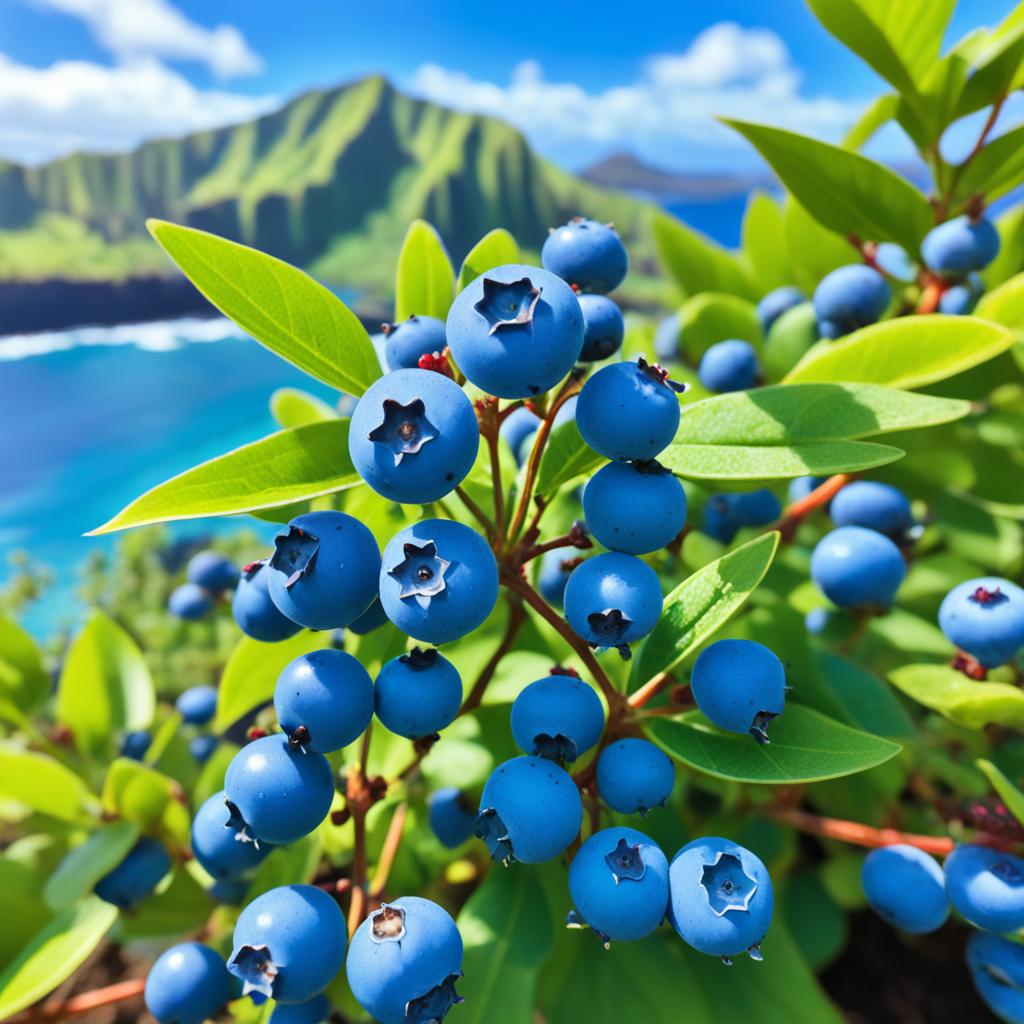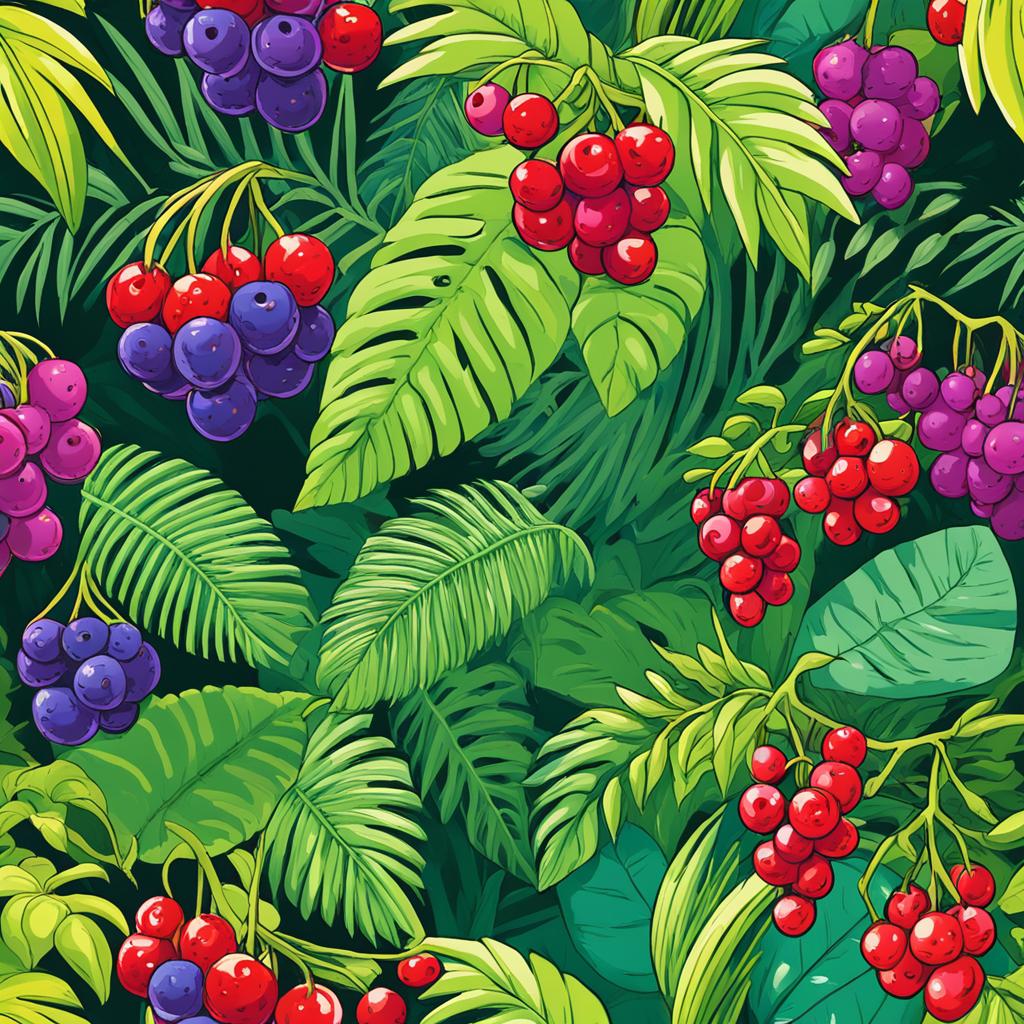Have you ever wondered what types of berries thrive in the lush tropical paradise of Hawaii? You might be surprised to discover the diverse range of berries that flourish in the Hawaiian islands. From the classic blueberry to exotic tropical fruits, Hawaii offers a bountiful selection of berries that are as delicious as they are unique.
When you think of Hawaii, you might envision palm trees, sandy beaches, and tropical fruits like pineapple and coconut. But did you know that blueberries can also be successfully grown in Hawaii’s warm climate? According to the College of Tropical Agriculture and Human Resources at the University of Hawaii, certain varieties of blueberries, known as low-chill or no-chill Southern Highbush, thrive at elevations ranging from 250 to 4,000 feet. These varieties include ‘Misty’, ‘Sharpblue’, ‘Sunshine Blue’, ‘Biloxi’, and ‘Sapphire’.
But blueberries are just the beginning. Hawaii is home to a wide array of exotic berries that offer a burst of tropical flavors. From the sweet caramel taste of abiu to the tanginess of acerola and the tartness of bilimbi, each fruit has its own unique characteristics. These berries can be found growing alongside other tropical delights like guavas, cacao, coffee, and cinnamon.
Growing berries in Hawaii comes with its own set of challenges. Birds, unsuitable soil conditions, and fungal diseases like blueberry rust can pose obstacles to successful cultivation. However, with the right techniques and care, you can enjoy a fruitful harvest of these tropical treasures.
So, are you ready to explore the world of berries in Hawaii? Join us as we delve into the different types of berries that grow in this tropical paradise, discover tips for successful cultivation, and explore the culinary and cultural significance of these delicious fruits.
Blueberries in Hawaii

Growing blueberries in Hawaii can be a rewarding endeavor, but it does come with its own set of challenges. However, with the right knowledge and techniques, you can successfully cultivate this delicious and nutritious fruit in the tropical paradise of Hawaii.
One of the main challenges of growing blueberries in Hawaii is the feeding by certain birds. Birds are attracted to the sweet and juicy berries, and they can quickly diminish your harvest. To protect your blueberry bushes, consider using netting or other bird repellent methods to deter them.
Another challenge is the soil conditions in Hawaii. Blueberries prefer acidic soil with a pH level between 4.5 and 5.5. However, the volcanic soil in Hawaii tends to be alkaline. To overcome this challenge, it is recommended to grow blueberries in pots with acidic potting mix, which allows you to control the soil conditions.
In addition to bird feeding and unsuitable soil conditions, blueberry rust is also a common problem in Hawaii. Blueberry rust is a fungal disease that affects the foliage and fruit of blueberry plants. To prevent the spread of the disease, it is important to practice good hygiene and remove any infected plant parts. In some cases, it may be necessary to use fungicides.
To mitigate these challenges, the College of Tropical Agriculture and Human Resources recommends growing blueberries in pots under protected conditions, such as in a greenhouse. This provides a controlled environment where you can regulate factors like temperature, humidity, and sunlight, creating optimal conditions for blueberry growth.
When selecting blueberry varieties for Hawaii, it is important to choose low-chill or no-chill Southern Highbush varieties. These varieties are adapted to the warmer climate of Hawaii and have a higher tolerance for the lack of chill hours. Some recommended blueberry varieties for Hawaii include ‘Misty’, ‘Sharpblue’, ‘Sunshine Blue’, ‘Biloxi’, and ‘Sapphire’.
With the right techniques and recommended blueberry varieties, you can overcome the challenges and enjoy the sweet taste of homegrown blueberries in Hawaii.
Exotic Berries in Hawaii

In addition to blueberries, Hawaii is home to a variety of exotic berries. These unique berries grow abundantly in the tropical paradise, thanks to the favorable climate and fertile soil. If you’re a fruit enthusiast, exploring the exotic berries of Hawaii will be a delightful experience for your taste buds.
One of the exotic berries you can find in Hawaii is the abiu. Known for its vibrant yellow color and sweet butterscotch caramel taste, the abiu is a tropical fruit tree that thrives in the Hawaiian climate. Another tropical fruit tree found in Hawaii is the acerola, also known as the Barbados cherry. This tangy berry is rich in vitamin C and is commonly used in juices, syrups, and even desserts.
When it comes to unique berries, Hawaii doesn’t disappoint. The bilimbi, also known as the cucumber tree, offers a tart flavor and is often used in pickles and curries. The black sapote, sometimes referred to as the chocolate pudding fruit, has a rich, creamy texture reminiscent of chocolate mousse. Hawaii is also home to the brazil cherry, breadfruit, cacao, cardamom, cinnamon, cloves, coffee, curry leaf, figs, guavas, and Himalayan blackberries.
Each of these exotic berries has its own distinct flavor and culinary applications. Whether you enjoy them fresh or incorporate them into your favorite recipes, these unique berries will add a tropical twist to your meals. From refreshing smoothies to delectable desserts, the possibilities are endless.
Exotic Berries in Hawaii
| Berry | Flavor | Culinary Applications |
|---|---|---|
| Abiu | Butterscotch caramel | Fresh consumption, desserts |
| Acerola | Tart | Juices, syrups, desserts |
| Bilimbi | Tart | Pickles, curries |
| Black Sapote | Chocolate-like | Desserts, smoothies |
| Brazil Cherry | Sweet, tropical | Snacking, desserts |
| Breadfruit | Starchy | Cooked as a vegetable |
| Cacao | Rich, chocolate-like | Chocolate-making |
| Cardamom | Aromatic, spicy | Culinary spice |
| Cinnamon | Sweet, aromatic | Culinary spice, desserts |
| Cloves | Strong, aromatic | Culinary spice |
| Coffee | Bitter, rich | Beverages |
| Curry Leaf | Aromatic, citrusy | Culinary spice, curries |
| Figs | Sweet, honey-like | Fresh consumption, desserts |
| Guavas | Sweet, tangy | Fresh consumption, jams |
| Himalayan Blackberries | Sweet, tart | Fresh consumption, desserts |
Growing Tips for Berries in Hawaii

Growing berries in Hawaii requires careful consideration of the unique climate and soil conditions in the islands. Whether you are cultivating blueberries or other varieties, following these tips will help ensure successful berry cultivation in Hawaii.
1. Pot Selection and Soil
When growing blueberries in Hawaii, it is recommended to use pots with an acidic potting mix. This helps replicate the ideal soil conditions blueberries prefer, as the natural soil in Hawaii may not be suitable. Opt for a well-draining potting mix with a pH level of around 4.5 to 5.5 to create an optimal growing environment for your blueberry plants.
2. Regular Fertilization
Providing regular fertilization is essential for the healthy growth and development of your berry plants. Blueberries benefit from fertilizers formulated specifically for acid-loving plants. Apply a slow-release organic fertilizer according to the package instructions to ensure a consistent supply of nutrients throughout the growing season.
3. Consistent Watering
Watering is a crucial aspect of caring for berries in Hawaii. It is important to maintain a moist but well-drained medium to prevent waterlogging or drying out of the soil. Water your berry plants consistently, ensuring the soil is evenly moist, especially during dry spells or hot weather. Avoid overwatering, as it can lead to root rot and other diseases.
4. Pest Management
Pests such as birds and caterpillars can pose a threat to your berry plants in Hawaii. To protect your plants from bird feeding, consider using bird netting or other protective barriers. If you notice signs of caterpillar infestation, like chewed leaves, implement non-toxic pest control methods such as handpicking or using organic biopesticides.
5. Pruning for Vigor and Productivity
Pruning is an important part of berry plant care in Hawaii. Regular pruning helps maintain plant vigor, encourages new growth, and improves overall productivity. Remove dead or diseased branches, and prune to shape the plants and promote proper air circulation.
| Berry Variety | Care Requirements |
|---|---|
| Blueberries | – Use pots with acidic potting mix – Regular fertilization – Consistent watering – Pest management – Pruning for vigor and productivity |
| Other Berry Varieties | – Research specific care requirements for each variety – Provide appropriate soil conditions – Water according to individual needs – Protect from pests – Prune as necessary |
By following these tips, you can ensure the successful cultivation of berries in Hawaii. Remember to research the specific care requirements of the berry varieties you are growing to provide the best conditions for their growth and productivity.
Importance and Uses of Berries in Hawaii
Berries in Hawaii hold immense practical and cultural significance. The culinary applications of Hawaii’s berries are diverse, as they can be enjoyed in a variety of ways. From consuming them fresh to using them in the creation of delicious jams, jellies, and desserts, these berries add a burst of flavor to any dish. In fact, they are often incorporated into traditional Hawaiian recipes, showcasing their cultural importance.
One popular berry in Hawaii is the blueberry, known for its antioxidant properties and beneficial nutrients. Enjoying blueberries not only satisfies your taste buds but also contributes to your overall health. The culinary world recognizes the rich benefits offered by Hawaii’s berries, making them a sought-after ingredient.
Aside from their nutritional and culinary value, Hawaiian berries also play a vital role in the cultural traditions and customs of the islands. Their presence in various dishes and festivals serves as a testament to the unique flavors and heritage of Hawaii. Whether it’s a special occasion or a regular meal, incorporating these berries adds a touch of authenticity to the culinary experience.
So next time you find yourself in Hawaii, be sure to indulge in the irresistible flavors of the islands’ berries. Whether enjoying them fresh, savoring them in a dessert, or experiencing their cultural significance, these berries are sure to leave a lasting impression.
FAQ
Q: What kinds of berries grow in Hawaii?
A: Hawaii offers a variety of berries that thrive in its tropical climate. Some of the berries that can be found growing in Hawaii include blueberries, abiu, acerola, banana ‘dwarf apple’, betel nut, bilimbi, black sapote, brazil cherry, breadfruit, cacao, cardamom, cinnamon, cloves, coffee, curry leaf, figs, guavas, and Himalayan blackberries.
Q: Can blueberries be grown in Hawaii?
A: Yes, blueberries can be successfully grown in Hawaii. Low-chill or no-chill Southern Highbush blueberry varieties such as ‘Misty’, ‘Sharpblue’, ‘Sunshine Blue’, ‘Biloxi’, and ‘Sapphire’ perform well at elevations ranging from 250 to 4,000 feet. However, there are some challenges to growing blueberries in Hawaii, including feeding by certain birds, unsuitable soil conditions, and a fungal disease called blueberry rust. It is recommended to grow blueberries in pots under protected (greenhouse) conditions to mitigate these problems.
Q: What are some exotic berries found in Hawaii?
A: In addition to blueberries, Hawaii is home to a variety of exotic berries such as abiu, acerola, banana ‘dwarf apple’, betel nut, bilimbi, black sapote, brazil cherry, breadfruit, cacao, cardamom, cinnamon, cloves, coffee, curry leaf, figs, guavas, and Himalayan blackberries. These berries offer unique flavors and can be used in various culinary applications.
Q: What are some tips for growing berries in Hawaii?
A: Growing berries in Hawaii requires special attention to the unique climate and soil conditions. For blueberries, it is recommended to use pots with acidic potting mix and provide regular fertilization. Watering should be consistent to maintain a moist but well-drained medium. Pests such as birds, fungal diseases like blueberry rust and botrytis blight, and caterpillars such as the Mexican leafroller can pose challenges. Pruning is important to maintain plant vigor and productivity. Different berries have specific care requirements, and proper care and maintenance will ensure successful cultivation in Hawaii.
Q: What is the importance and uses of berries in Hawaii?
A: Berries in Hawaii have both practical and cultural significance. They can be used in a variety of culinary applications, including fresh consumption, making jams, jellies, and desserts, and even in traditional Hawaiian dishes. In addition to their nutritional value, berries also hold cultural importance in Hawaiian traditions and customs. Their presence in dishes and festivals showcases the unique flavors and heritage of the Hawaiian islands.
